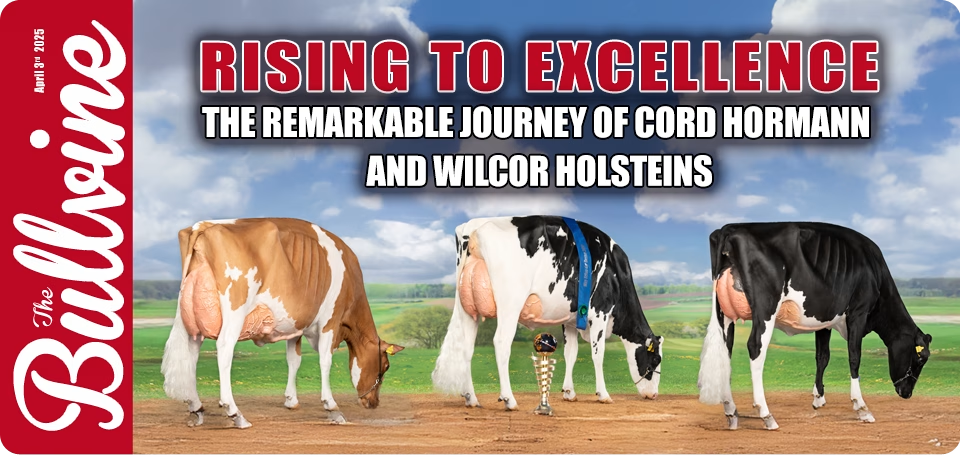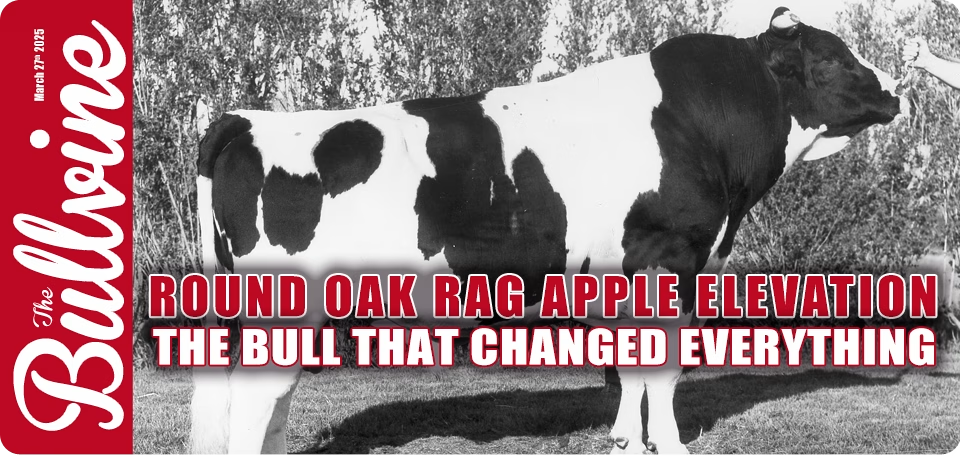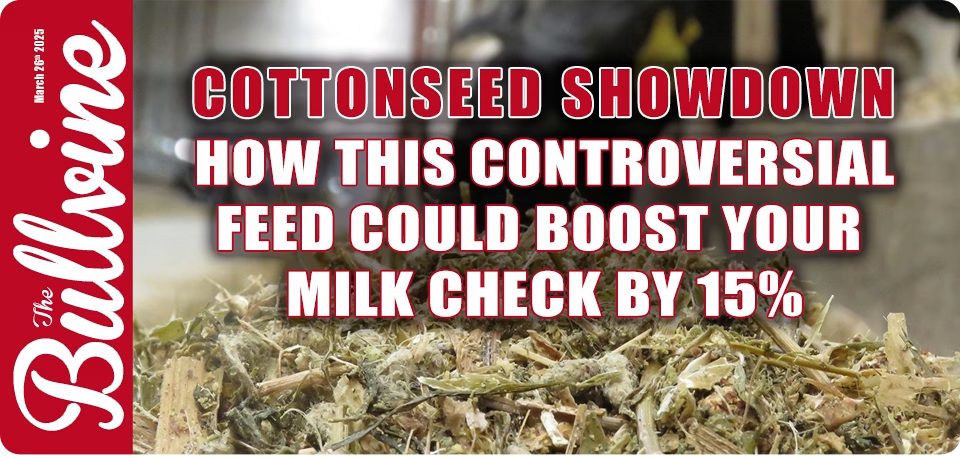Latest News
 U.S. Dairy Exports in February 2025: How Can Record Values Coexist with Plummeting Volumes?Cheese exports boom 14% while NFDM crashes 28%: How U.S. dairy walks the tariff tightrope between record profits and market chaos. EXECUTIVE SUMMARY: February 2 […]
U.S. Dairy Exports in February 2025: How Can Record Values Coexist with Plummeting Volumes?Cheese exports boom 14% while NFDM crashes 28%: How U.S. dairy walks the tariff tightrope between record profits and market chaos. EXECUTIVE SUMMARY: February 2 […] CME Dairy Market Report: April 3, 2025 – Cheese Markets Crash as Demand FaltersCheese prices crash 3.5¢ as demand falters; futures premiums signal trader optimism. Global trade wars loom over dairy exports. EXECUTIVE SUMMARY: The CME dairy […]
CME Dairy Market Report: April 3, 2025 – Cheese Markets Crash as Demand FaltersCheese prices crash 3.5¢ as demand falters; futures premiums signal trader optimism. Global trade wars loom over dairy exports. EXECUTIVE SUMMARY: The CME dairy […] From Farm to ‘Shark Tank’: Connecticut Dairy Farmer’s Eco-Friendly Innovation Takes the StageCT dairy farmer Amanda Freund brings manure magic to Shark Tank! Her biodegradable CowPots could revolutionize sustainable farming. Amanda Freund, a Connecticut […]
From Farm to ‘Shark Tank’: Connecticut Dairy Farmer’s Eco-Friendly Innovation Takes the StageCT dairy farmer Amanda Freund brings manure magic to Shark Tank! Her biodegradable CowPots could revolutionize sustainable farming. Amanda Freund, a Connecticut […] Tariff Showdown: EU Dairy Faces 20% US Barrier While NZ Gets Half the Heat20% US tariffs hit EU dairy: Ireland's Kerrygold exports at risk while NZ pays half. Trade war looms—who pays the price? EXECUTIVE SUMMARY: The US has imposed 2 […]
Tariff Showdown: EU Dairy Faces 20% US Barrier While NZ Gets Half the Heat20% US tariffs hit EU dairy: Ireland's Kerrygold exports at risk while NZ pays half. Trade war looms—who pays the price? EXECUTIVE SUMMARY: The US has imposed 2 […]Hungary Deploys Military as Foot-and-Mouth Disease Spreads
Hungary deploys troops against the worst FMD outbreak in 50 years, and it has discovered critical biosecurity lessons for dairy farms facing global disease thre […]
More News
- Trump’s Liberation Day Tariffs: A $8.2B Gamble for Dairy Farmers
- Whole Milk Showdown: Senate Hearing Reveals Shocking Dairy Decline as Legislation Fights to Restore School Choice
- CME Daily Dairy Market Report – April 2, 2025 – Cheddar Barrel Prices Surge 3.75¢ While Blocks Edge Higher; Dry Whey Weakens Amid Mixed Market
- Will Your Dairy Farm Survive the Next Decade? The Brutal Math of Consolidation
- Is Trump’s Dairy Trade War with Canada Doomed Before It Begins? The $17 Billion Standoff You Can’t Afford to Miss
- April 2025 US Holstein Evaluations: Genetic Base Change Reshuffles Rankings While Elite Bulls Hold Strong
- Bird Flu and Milk: The Unshakeable Science Protecting Your Bulk Tank
- Is Dairy Outsmarting Weight-Loss Drugs and Plant-Based Fads? The Protein Snack Revolution You Can’t Ignore
- Cornocalypse 2025: How America’s Record Corn Planting Will Make or Break Your Dairy Operation
- CME Daily Dairy Market Report: April 1, 2025 – Cheese Prices Surge Amid Active Trading; Class III Futures Remain Above USDA Q2 Forecast
Top News Posts from Past Week
- Top 100 TPI Sires: April 2025
- Canadian Sire Lists Showcase Major Shifts in April 2025 Evaluations
- Will Your Dairy Farm Survive the Next Decade? The Brutal Math of Consolidation
- April 2025 US Holstein Evaluations: Genetic Base Change Reshuffles Rankings While Elite Bulls Hold Strong
- Mega-Dairy Revolution: Inside the World’s 10 Largest Dairy Farms
- Genetic Revolution: How Record-Breaking Milk Components Are Reshaping Dairy’s Future
- 2025 U.S. Genetic Base Change: Final Values and Strategic Implications
- Australia’s Dairy Crisis: Tough Truths Behind 2025’s Production Decline
- Is Trump’s Dairy Trade War with Canada Doomed Before It Begins? The $17 Billion Standoff You Can’t Afford to Miss
- The $1,200 Heifer Paradox: Why Your Healthiest Cows May Produce Your Worst Replacements
Feature Articles
Rising to Excellence: The Remarkable Journey of Cord Hormann and Wilcor Holsteins
From a 16-cow tie-stall to international glory: How Cord Hormann built Wilcor Holsteins into Germany's elite breeding program through vision and patience. E219 […]April 2025 Global Holstein Evaluations: New Leaders Emerge as Genetic Progress Accelerates Worldwide
Historic US genetic base shift meets global polled revolution in April 2025 Holstein rankings – discover new leaders reshaping dairy genetics. E218 April 2025 G […]Northeast Spring National Holstein Show 2025
March 31st, 2025 @ Hamburg, NY E217 Northeast Spring National Holstein Show 2025 | RSS.com The New York Spring Holstein Show, judged by Ryan Krohlow, showcased […]When Cows Were Kings: Revisiting Carnation’s Golden Age of Dairy Breeding
How the 1900s 'contented cows' sparked a dairy revolution: Carnation Farms blended animal welfare with cutting-edge science to create genetics that still shape […]BEEF-ON-DAIRY REVOLUTION: Former Dairy Farmers Finding Gold in the Beef Market Corporate Giants Overlooked
While mega-dairies grabbed headlines, small farmers quietly hijacked beef genetics – creating a stealth revolution corporate giants never saw coming. E214 BEEF- […]
More Articles
- BST Reapproval: The Key to Unlocking Dairy Sustainability
- Round Oak Rag Apple Elevation: The Bull That Changed Everything
- Cottonseed Showdown: How This Controversial Feed Could Boost Your Milk Check by 15%
- Making Dreams Come True: The Journey of Tom & Kelli Cull
- The Great Holstein Shakeup: How 16 Years Rewrote Breeding Rules
- Michael Heath’s Enduring Legacy: How One Man’s Passion Redefined Dairy Excellence
- How Smart Dairy Farmers Are Slashing Methane While Boosting Profits
- The Cow That Built an Empire: Comestar Laurie Sheik’s Unstoppable Genetic Legacy
- Bird Flu Bombshell: Dairy Cows Losing a Full Ton of Milk with No Recovery
- GENETIC GIANTS DETHRONED: How Dairy Farmers and Beef Upstarts Hijacked 75% of the Beef-on-Dairy Gold Rush
Top Feature Articles from the Past Month
- Top 15 Best Milk Brands in the USA: Unveiling the Cream of the Crop
- Northeast Spring National Holstein Show 2025
- 10 Sires To Breed The Next World Dairy Expo Grand Champion
- The Cow That Built an Empire: Comestar Laurie Sheik’s Unstoppable Genetic Legacy
- Why Donald Trump Hates Canada’s Dairy Supply System
- CAPTAIN: The Bull That Rewrote the Rules for Modern Breeding
- Making Dreams Come True: The Journey of Tom & Kelli Cull
- The $4,300 Gamble That Reshaped Global Dairy Industry: The Pawnee Farm Arlinda Chief Story
- From Pasture to Powerhouse: The GenoSource Story
- FROM TRAGEDY TO TRIUMPH: The Unstoppable Journey of Holstein Legend Nico Bons
- Rising to Excellence: The Remarkable Journey of Cord Hormann and Wilcor Holsteins
-
Rising to Excellence: The Remarkable Journey of Co…
Karen Hunt Apr 3, 2025From a 16-cow tie-stall to international glory: How Cord Hormann built Wilcor Holsteins into Germany's elite breeding program through vision and patience. E219 Rising to Excellence: The Remarkable Journey | RSS.com Cord Hormann accepts the prestigious Grand Champion trophy for O Katy at the… Read More - April 2025 Global Holstein Evaluations: New Leaders Emerge as Genetic Progress Accelerates Worldwide
-
April 2025 Global Holstein Evaluations: New Leader…
Andrew Hunt Apr 2, 2025Historic US genetic base shift meets global polled revolution in April 2025 Holstein rankings – discover new leaders reshaping dairy genetics. E218 April 2025 Global Holstein Evaluations: New L | RSS.com The April 2025 genetic evaluations for Holstein cattle have arrived, revealing significan… Read More
- Northeast Spring National Holstein Show 2025
-
Northeast Spring National Holstein Show 2025
Andrew Hunt Mar 31, 2025March 31st, 2025 @ Hamburg, NY E217 Northeast Spring National Holstein Show 2025 | RSS.com The New York Spring Holstein Show, judged by Ryan Krohlow, showcased exceptional dairy cattle across multiple age divisions. The competition featured remarkable depth of quality throughout,… Read More
- When Cows Were Kings: Revisiting Carnation’s Golden Age of Dairy Breeding
-
When Cows Were Kings: Revisiting Carnation’s Golde…
Andrew Hunt Mar 30, 2025How the 1900s 'contented cows' sparked a dairy revolution: Carnation Farms blended animal welfare with cutting-edge science to create genetics that still shape modern herds. E216 When Cows Were Kings: Revisiting Carnation’s | RSS.com A Pastoral Legacy: Holstein dairy cattle graze peacefully… Read More
- BEEF-ON-DAIRY REVOLUTION: Former Dairy Farmers Finding Gold in the Beef Market Corporate Giants Overlooked
-
BEEF-ON-DAIRY REVOLUTION: Former Dairy Farmers Fin…
Andrew Hunt Mar 29, 2025While mega-dairies grabbed headlines, small farmers quietly hijacked beef genetics – creating a stealth revolution corporate giants never saw coming. E214 BEEF-ON-DAIRY REVOLUTION: Former Dairy Farmer | RSS.com The dairy establishment missed it completely. While industry leaders were busy bui… Read More
- BST Reapproval: The Key to Unlocking Dairy Sustainability
-
BST Reapproval: The Key to Unlocking Dairy Sustain…
Andrew Hunt Mar 28, 2025BST: Dairy’s Controversial Climate Hero? Discover how this taboo tech slashes emissions and boosts efficiency—plus why the industry’s sustainability future hinges on embracing it. E213 BST Reapproval: The Key to Unlocking Dairy Su | RSS.com The future of dairy farming is facing a critical mom… Read More
- Round Oak Rag Apple Elevation: The Bull That Changed Everything
-
Round Oak Rag Apple Elevation: The Bull That Chang…
Andrew Hunt Mar 27, 2025Born from an unlikely mating, one bull revolutionized global dairy breeding with genetics so powerful they still dominate herds 60 years later. E212 Round Oak Rag Apple Elevation: The Bull That | RSS.com Round Oak Rag Apple Elevation (1965-1979), the legendary Holstein sire dubbed “Bull of t… Read More
- Cottonseed Showdown: How This Controversial Feed Could Boost Your Milk Check by 15%
-
Cottonseed Showdown: How This Controversial Feed C…
Andrew Hunt Mar 26, 2025Controversial feed boosts milk checks by 15%? New research reveals how whole cottonseed could be your dairy profit game-changer! E211 Cottonseed Showdown: How This Controversial F | RSS.com Forget what you've heard about cottonseed risks—new research published in the Journal of Dairy Science… Read More
- Making Dreams Come True: The Journey of Tom & Kelli Cull
-
Making Dreams Come True: The Journey of Tom &…
Karen Hunt Mar 25, 2025From small farms to industry legends: How Tom & Kelli Cull’s grit, innovation, and "Never Give Up" mantra turned Budjon Farms into a dairy dynasty. E210 Making Dreams Come True: The Journey of Tom & | RSS.com Have you ever met someone whose passion is so infectious that you want to drop e… Read More
- The Great Holstein Shakeup: How 16 Years Rewrote Breeding Rules
-
The Great Holstein Shakeup: How 16 Years Rewrote B…
Murray Hunt Mar 24, 2025How Holstein breeding flipped from show-ring beauty to farm profitability: The 16-year revolution that's transforming dairy genetics forever. E208 The Great Holstein Shakeup: How 16 Years Rewr | RSS.com Do you know what blows my mind? How completely different Holstein breeding looks today com… Read More
Tanbark Trail
Northeast Spring National Holstein Show 2025
March 31st, 2025 @ Hamburg, NY E217 Northeast Spring National Holstein Show 2025 | RSS.com The New York Spring Holstein Show, judged by Ryan Krohlow, showcased exceptional dairy cattle across multiple age divisions. The competition featured remarkabl […]Is Erbacers Snapple Shakira One of the Greatest Show Cows of All Time?
Uncover why Erbacres Snapple Shakira stands among the top dairy show cows of all time. What makes her excel in the competitive dairy arena? E55 Is Erbacers Snapple Shakira One of the Greatest Show Cows of All Time? From the moment she steps into the […]The Royal Winter Fair 2024 – Jersey
Judge Jeff Sales NTENSE JOEL DELPHIE ETGrand ChampionThe Royal - Jersey Show 2024WEEKSDALE/HI-CALIBER/ROCK ALLEN/F&D BORBA, BREADALBANE, PE c LEACHLAND VIDEO MOCHA K Intermediate Champion The Royal - Jersey Show 2024 WEEKSDALE HOLSTEINS, BRE […]The Royal Winter Fair 2024 – Holstein
Judge Blair Weeks JEFFREY-WAY HARD ROCK TWIGS Grand Champion The Royal - Holstein Show 2024 K. DOEBERIENER, L. BOWEN & PAT CONROY, R&F LIVESTOCK INC, & WALKER DAIRY INC. Grand Champion: Jeffrey-Way Hard Rock Twigs, 1st 4-year-old, K Doebe […]The Royal Winter Fair 2024 – Red & White Holstein
November 4th 2024 Judge: Markus Hehli, Rimbey, AB PREMIUM APPLE CRISP LILLY Grand Champion The Royal - Red & White Holstein Show BUTLERVIEW FARM, CHEBANSE, IL Grand Champion: Premium Apple Crisp Lilly (Apple-Crisp), 1st 5-year-old, Butlerview Far […]
The Bullvine LLC © 2025 | Terms of Use | Community Guidelines | Privacy Policy |
Manage Consent
To provide the best experiences, we use technologies like cookies to store and/or access device information. Consenting to these technologies will allow us to process data such as browsing behavior or unique IDs on this site. Not consenting or withdrawing consent, may adversely affect certain features and functions.
Functional Always active
The technical storage or access is strictly necessary for the legitimate purpose of enabling the use of a specific service explicitly requested by the subscriber or user, or for the sole purpose of carrying out the transmission of a communication over an electronic communications network.
Preferences
The technical storage or access is necessary for the legitimate purpose of storing preferences that are not requested by the subscriber or user.
Statistics
The technical storage or access that is used exclusively for statistical purposes.
The technical storage or access that is used exclusively for anonymous statistical purposes. Without a subpoena, voluntary compliance on the part of your Internet Service Provider, or additional records from a third party, information stored or retrieved for this purpose alone cannot usually be used to identify you.
Marketing
The technical storage or access is required to create user profiles to send advertising, or to track the user on a website or across several websites for similar marketing purposes.

























